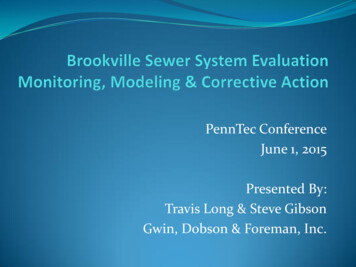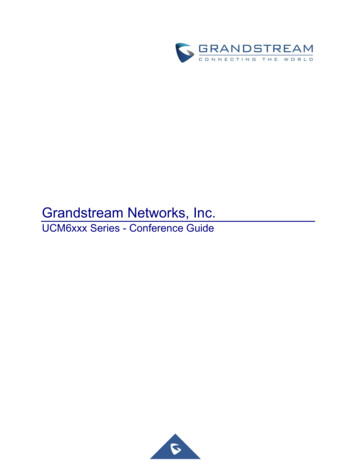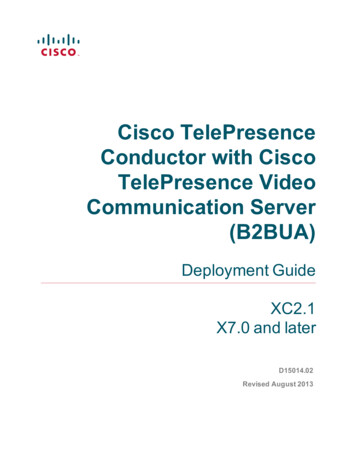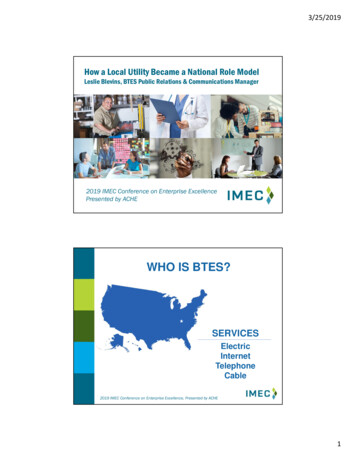
Transcription
PennTec ConferenceJune 1, 2015Presented By:Travis Long & Steve GibsonGwin, Dobson & Foreman, Inc.
Outline Brookville Sewer System Evaluation System Overview Overflow Regulatory Problems Flow Monitoring Diagnostic Evaluation Hydraulic Modeling Analysis Compliance Projects Questions
System Overview Brookville Municipal Authority (BMA) Wastewater System Service Area – 2,500 customers in Brookville Borough & Pine Creek,Rose and Knox TownshipsAuthority owns 42 miles of interceptor and collection sewers, 5sewage lift stations and a regional wastewater treatment plantSeparate sewer system with sanitary sewer overflows (SSO’s)BMA under Consent Order & Agreement to eliminate overflows Fined per overflow eventBrookville, PA
Brookville SewerService AreaRose Twp.Brookville Boro.Rose Twp.Rose Twp.Rose Twp.Pine Creek Twp.BMA WWTFWWTF OutfallRose Twp.
System ComponentsBROOKVILLEWASTEWATERCOLLECTION SYSTEM
System Description Sewer system – 220,000 LF of 6”-18” pipe 1 main pump station and 4 small lift stations Sewage collection system is 75-100 years old Interceptor sewer system and original treatment plant(primary treatment) were constructed in 1959 Plant upgraded to secondary treatment (RBC’s) andWhite Street pump station and new forcemain/interceptor sewer were installed in 1984
Sanitary Sewer Overflows (SSO’s) System originally had 5 overflows; 3 SSO’s were closed Two (2) active SSO’s to alleviate hydraulic surchargingduring wet weather events White Street Pump Station SSO Plant Bypass SSO SSO’s discharge to Redbank Creek
White Street Pump Station SSO Station capacity – 4.85 MGD Located 1 mile above plant
Plant Bypass SSO Automatic Valve Controls Flow intoTreatment Plant (4 MGD, max.) Bypass Chamber has a ManualSluice Gate that Controls Flow to 18”Bypass Line; Ultrasonic Level ProbeRecords Overflow
Chapter 94 Overflow Summary (2008-2014)
Regulatory Action PADEP regulatory action (Consent Order) forced thecommunity to initiate corrective action to eliminate SSO’s Act 537 Plan Update was deemed a necessity by DEP sincelast update was done 35 years ago Authority faced with either removing I/I; expanding sewersystem & treatment plant; or both to abate SSO’s Physical condition of system was an additional factor: Treatment plant - many aging and deteriorated components Process - often not functional with very high maintenance costs Interceptor sewers – under capacity and deteriorated
Consent Order - Corrective ActionCompliance Plan Flow MonitoringManhole InspectionsDye and Smoke TestingSewer Cleaning & TelevisingInflow and Infiltration AnalysisSewer System EvaluationCompliance ProjectsCompliance ScheduleUpdate & Submit Act 537 Plan
Conveyance System Flow Monitoring Initial program monitored flows at 10 strategic locationsin the main conveyance system and SSOs 13 flow monitoring locations from 2013 to 2015 Combination of area-velocity, flow tube& ultrasonic level probe meters Authority maintained & serviced meters
Flow Monitoring Devices Area-Velocity Meters (Sewer SystemContinuous wave Doppler technology measures averagevelocity Primarily used in areas not prone to surcharge conditions Flow-Tube Meters (Sewer System) Transducers estimate flow through pressure differential in theupstream and downstream sections of the meter Installed in surcharge areas (pressure pipe flow) and insubmerged overflow pipes with the potential for reverse flow Ultrasonic Level Probe Meters (Plant Bypass) Rain Gage Tipping Bucket recorded hourly precipitation to develop flowrainfall relationships
Average plant ADF (0.8mgd) to peak flowsshow persistent, elevated peaking factors.Note: Data is for plant only - does NOTinclude overflow component!Brookville Wet Weather Event Hydrograph
Most wet weather event hydrographs showsharp peaks with short time-to-peak risetimes and rapidly receding flow.Data suggests a severe inflow problemTypical Wet Weather Hydrograph Composite
Flow Monitoring ResultsStudy Period from April 2013 to April 2015 One-third of significant rainfall events (22 of 65)caused overflows Plant Capacity: 1.25 MGD, Peak Capacity: 4.o MGD Average Peak Wet Weather Overflow Event: 6.5 MGD Peak SSO Discharge Volume: 4.5 Million Gallons Peak SSO Discharge Rate: 6.4 MGD Peak Hourly Total Flow: 10-15 MGD Peak Rainfall Event: 3.44 inches in 14 hours Maximum Rainfall Intensity: 1.62 inches/hour 21 Events with Peak Hourly Flow 4 MGD or Greater 2 events with Peak Hourly Flow 10 MGD or Greater
Peak Overflow Rates & Rainfall Intensity Relationship 1 inch per hour rainfall will produce 10 MGD system flow 0.5 inch per hour rainfall will produce 5 MGD system flow Most wet weather event hydrographs show sharp peaks withshort time-to-peak rise times and rapidly receding flow Data suggests a severe inflow problem
Diagnostic Work Manhole Inspections - Interceptor Sewer Cleaning & Televising of Conveyance System Smoke Testing (Selective High Inflow Areas) Dye Testing of Suspected Direct Cross Connections
Location of Conveyance System Diagnostic Work
Manhole InspectionsBrick Manhole Subject toInfiltrationManhole Subject to Inflow
Sewer Cleaning Televising Work Brookville cleaned and televised all major interceptorlines for condition and available capacity in 2013 & 2014 Contracted with private firm to perform work TV inspection work totaled 26,613 feet (5 miles)
Main Interceptor Infiltration
Root Intrusion (60% Blockage)
Main Conveyance Sewer - Deformed & Collapsed Pipe
Multiple Pipe Fractures and Deformed Pipe
Gas Lines Through Sewer Pipe
Volunteer Sewer Inspector
Summary of Sewer Televising Deficiencies
Selective Smoke & Dye Testing Goal is to identify possible cross connections and inflow tothe sewer system Introduction of non-toxic smoke into sewer system forinterconnection of: Roof leaders Area drains Broken main lines Leaking manholes Storm sewer crossconnections Follow-up dye testing BMA enforcement of illegal connections removal
Defective Brick Manhole
Building Lateral DefectsIllegal Roof Leader
Analysis Tools - Hydraulic Modeling Interceptor System modeled using Bentley SewerGEMSV8i software for capacity analysis System Model Gravity interceptorsSubmerged outfallsPump stationsForce mainsOverflowsInverted siphons
Model Input Model created from data on as-built sewer drawings andfield instrument surveys Physical Data Pipe materials, lengths, diameters Manhole diameters, invert and rim elevations, locations Pump stations Inverted siphons Overflow configurations
Model Input
Model Calibration Model calibrated with flow monitoring data duringbaseline conditions and wet weather events Model output of Hydraulic Grade Line elevations werecompared to monitoring data at key locations in thesewer system Model calibrated to achieve an allowable tolerance (3inches) for the Hydraulic Grade Line
Modeling Results – Existing System Majority of main interceptor sewer system has insufficientcapacity to convey peak flows without surcharging Without bypassing, surcharging of main lines will result insewer backups on private property Verification of SSO overflow rates
System Map of Hydraulically Overloaded SectionsBased on Hydraulic ModelingPipe Segments WhereMetered Peak FlowsExceed Hydraulic Capacityof Interceptor Sewer
Modeling & Design of Future Conveyance System Modeling found that a conveyance capacity of 10 MGD issufficient for the peak flows generated in sewer system Model was used to design new interceptors sewers based onphysical restrictions of system River crossingsCollection system interconnectionsAvailable slope Modeling provided design parameters for new White Streetpump station Conveyance system upgrades will convey all flow to thetreatment plant without surcharging or bypassing
Sewer System Options to Eliminate SSO’s Non-Structural Alternative: Full Inflow Removal Aggressive targeting & enforcement of private inflow removal Borough to remove any storm sewer cross-connections Lack of an adequate storm sewer system a major problem Documented sewer deficiencies remain Replace Entire Sewer System and No Inflow Removal Will reduce infiltration (analysis shows it is not a major problem) Very costly and may not solve SSO problem without plant expansion Replace Entire Sewer System with Inflow Removal Building lateral replacement must be included Permanent, ongoing inspection and enforcement program a necessity Major commitment of annual Authority personnel and resources Very costly, may not solve long term inflow problem - the source of SSO’s
Wastewater Treatment Facility Existing plant is old and deterioratedLack of process flexibility &adaptation for future upgradeInadequate capacity fortreating peak flows (10 mgd )Maintenance intensiveUpstream pump station andinterceptors have low capacityDiagnostic work shows poorcondition of interceptorsCondition of plant & sewerlines warrant major projectregardless of capacityconcerns!
Final Compliance Plan Authority stated it has insufficient resources and personnel neededfor an annual I/I removal, maintenance & enforcement program Lack of a storm sewer system complicates inflow removal due toAuthority concerns of localized flooding, icing and propertydrainage Blended approach for SSO compliance was recommended Compliance Plan Replace Interceptor Sewer System with Higher Capacity Lines Replace White Street Pump Station with Larger Pumps Upgrade and Expand Wastewater Treatment Plant Perform Targeted Inflow Removal to Reduce System Peak Flowto 10 MGD
Map of Brookville ConveyanceSystem and Treatment FacilityCompliance Projects
Compliance Projects and Goals Projects Interceptor Sewer Replacement (28,000 LF of 12-30” pipe) - 6.5 million New White Street Pump Station (10 mgd capacity) - 1.5 million Wastewater Treatment Plant: 12 million Total Project Cost: 20 million Funding: RUS Loan- 9 million/RUS Grant- 8.5 million/PennworksGrant- 2.5 million Targeted Inflow Reduction: BMA televising, smoke testing, inspection Anticipated Results Regulatory compliance for SSO removal Replacement of deficient and deteriorated system components Plant will have treatment capacity for all wet weather flow System will have capacity for future growth and development Plant has flexibility for achieving future nutrient removal Affordable project financing resulting in 46/EDU monthly sewer rate
System Overview Brookville Municipal Authority (BMA) Wastewater System Service Area - 2,500 customers in Brookville Borough & Pine Creek, Rose and Knox Townships Authority owns 42 miles of interceptor and collection sewers, 5 sewage lift stations and a regional wastewater treatment plant Separate sewer system with sanitary sewer overflows (SSO's)










